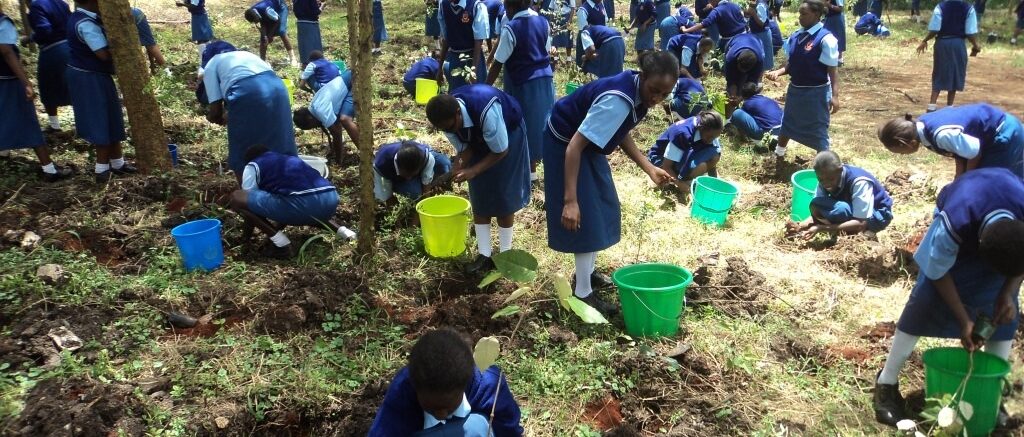Approach 3: Engaging Schools to achieve Tree Planting Initiative
Creating planted spaces in primary schools, with the active involvement of school management committees, pupils, and students in the southern sector, is a commendable initiative that not only contributes to environmental conservation but also serves as an educational tool. Here’s a guide on how NCCDO will achieve this approach:
1. Collaboration with School Management Committees:
- Engagement Meetings:
Initiate engagement meetings with school management committees to discuss the benefits and objectives of creating planted spaces in primary schools. Share the vision and seek their support.
- Educational Workshops:
Conduct workshops for school management committees to educate them about the importance of planted spaces, their impact on the environment, and the educational value for students.
2. Integration into School Curriculum:
- Curriculum Alignment:
Collaborate with educational authorities to align the creation of planted spaces with the school curriculum. This integration ensures that environmental education becomes an integral part of students’ learning experiences.
- Lesson Plans:
Develop lesson plans and educational materials that can be used by teachers to incorporate topics related to planted spaces, tree planting, and environmental stewardship into their lessons.
3. Student and Pupil Involvement:
- Formation of Eco-Clubs:
Facilitate the formation of eco-clubs within schools, comprising interested students and pupils. These clubs can take a lead role in managing planted spaces and organizing related activities.
- Student Workshops:
Conduct workshops for students to educate them about the importance of planted spaces, the role of trees in the environment, and the positive impact on their school and community.
4. Practical Learning Sessions:
- Tree Planting Events:
Organize tree planting events within school premises, involving both students and members of the school management committee. These events provide practical experience and foster a sense of ownership.
- Hands-On Maintenance Activities:
Plan regular hands-on maintenance activities for students, such as watering, weeding, and caring for the planted spaces. This encourages a continuous connection with the environment.
5. Community Participation:
- Community Days:
Organize community days where parents, community members, and local stakeholders are invited to participate in tree planting events and other activities related to the planted spaces.
- Community Workshops:
Extend educational workshops to the broader community, emphasizing the significance of planted spaces in schools and the role of community members in supporting these initiatives.
6. Environmental Education Programs:
- Guest Speakers and Experts:
Invite environmental experts or local authorities to conduct guest lectures and interactive sessions in schools. This enhances students’ understanding of environmental issues and the importance of conservation.
- Field Trips:
Organize field trips to nearby natural areas, botanical gardens, or conservation sites. These trips provide students with practical exposure and a deeper appreciation for nature.
7. Monitoring and Evaluation:
- Establish Monitoring Protocols:
Develop monitoring protocols to assess the growth and health of planted spaces. This could include regular assessments of tree growth, biodiversity, and the overall impact on the school environment.
- Student-Led Assessments:
Empower students to actively participate in monitoring and evaluating the planted spaces. This involvement fosters a sense of responsibility and connection to the project.
8. Recognition and Rewards:
- Certificates and Awards:
Introduce certificates and awards for students, pupils, and school management committees that actively contribute to the success of planted spaces. Recognition enhances motivation and a sense of achievement.
- Celebration Events:
Organize special events or ceremonies within schools to celebrate milestones, such as the growth of planted spaces, successful tree plantings, or achievements in environmental education.
9. Long-Term Sustainability Planning:
- Incorporate into School Development Plans:
Work with school management committees to integrate the concept of planted spaces into the long-term school development plans. This ensures that the initiative becomes a permanent and integral aspect of the school’s culture.
- Capacity Building for Sustainability:
Provide capacity-building programs for teachers, students, and school management committees on sustainable practices, including tree care, biodiversity conservation, and environmental sustainability.
10. Communication and Community Awareness:
- Showcasing Success Stories:
Share success stories and progress updates through school newsletters, local media, and social media platforms. This showcases the positive impact of planted spaces and encourages community-wide participation.
- Community Engagement Platforms:
Utilize community engagement platforms, such as parent-teacher meetings and community gatherings, to communicate the importance of the initiative and garner ongoing support.
